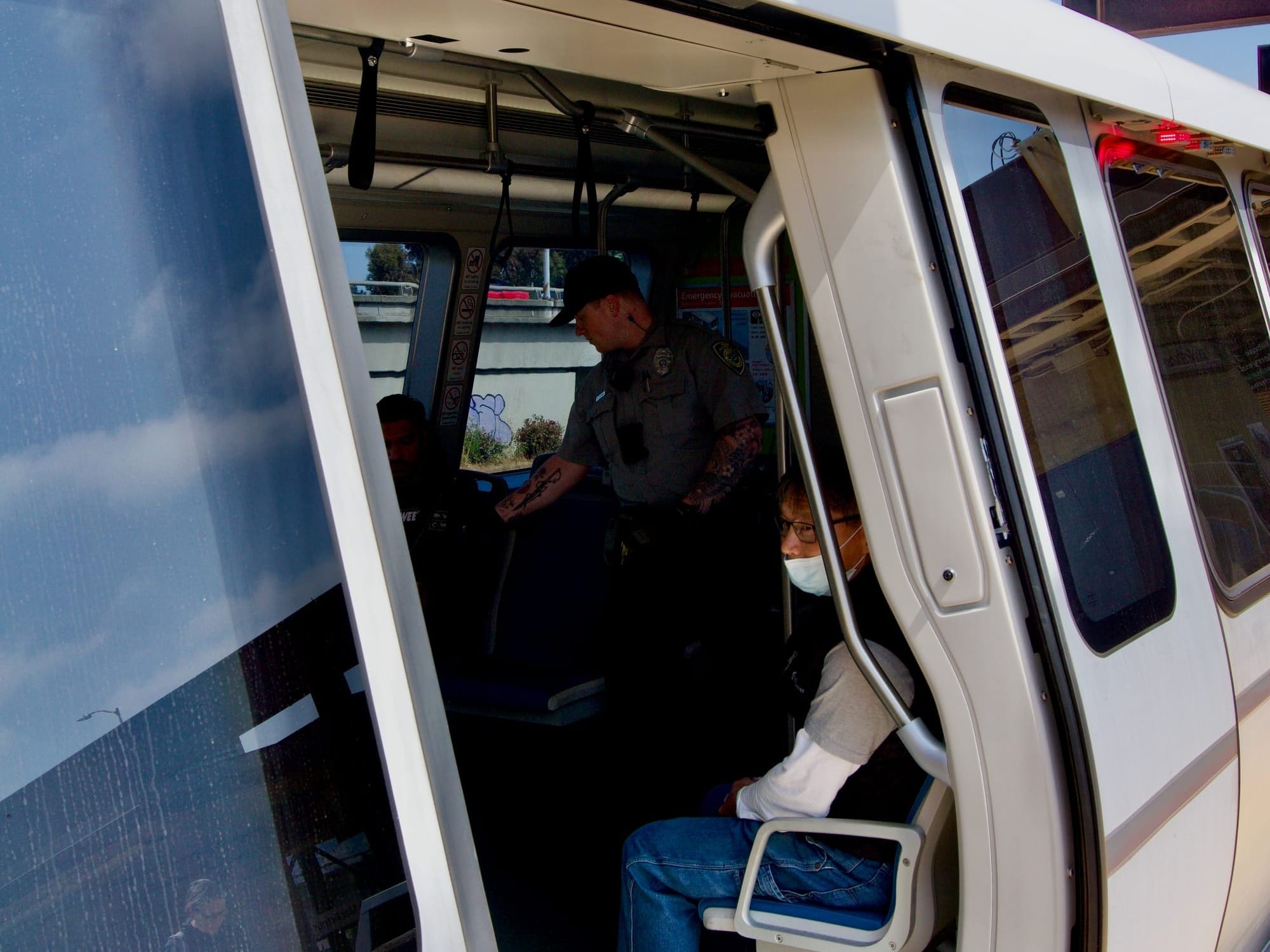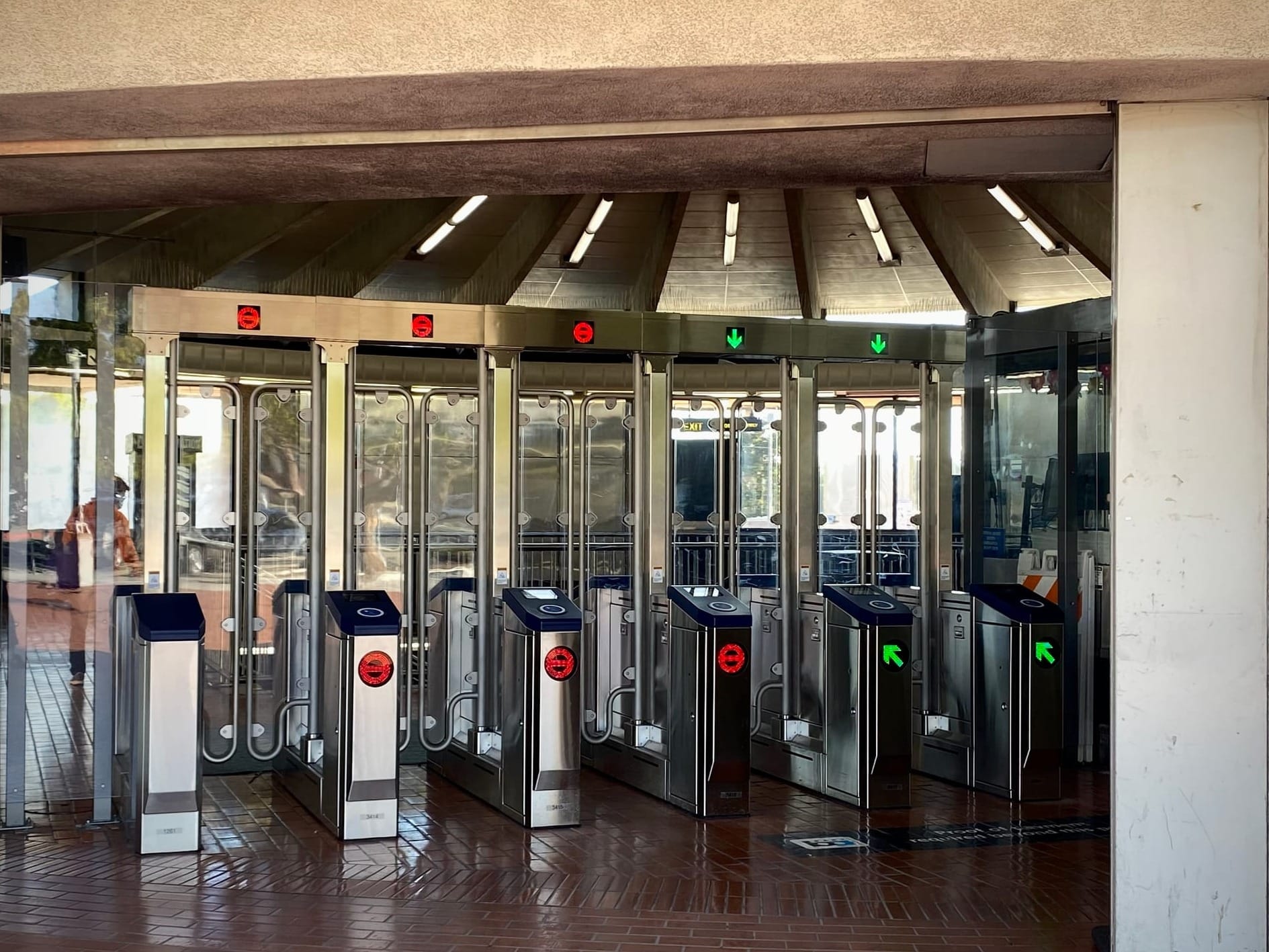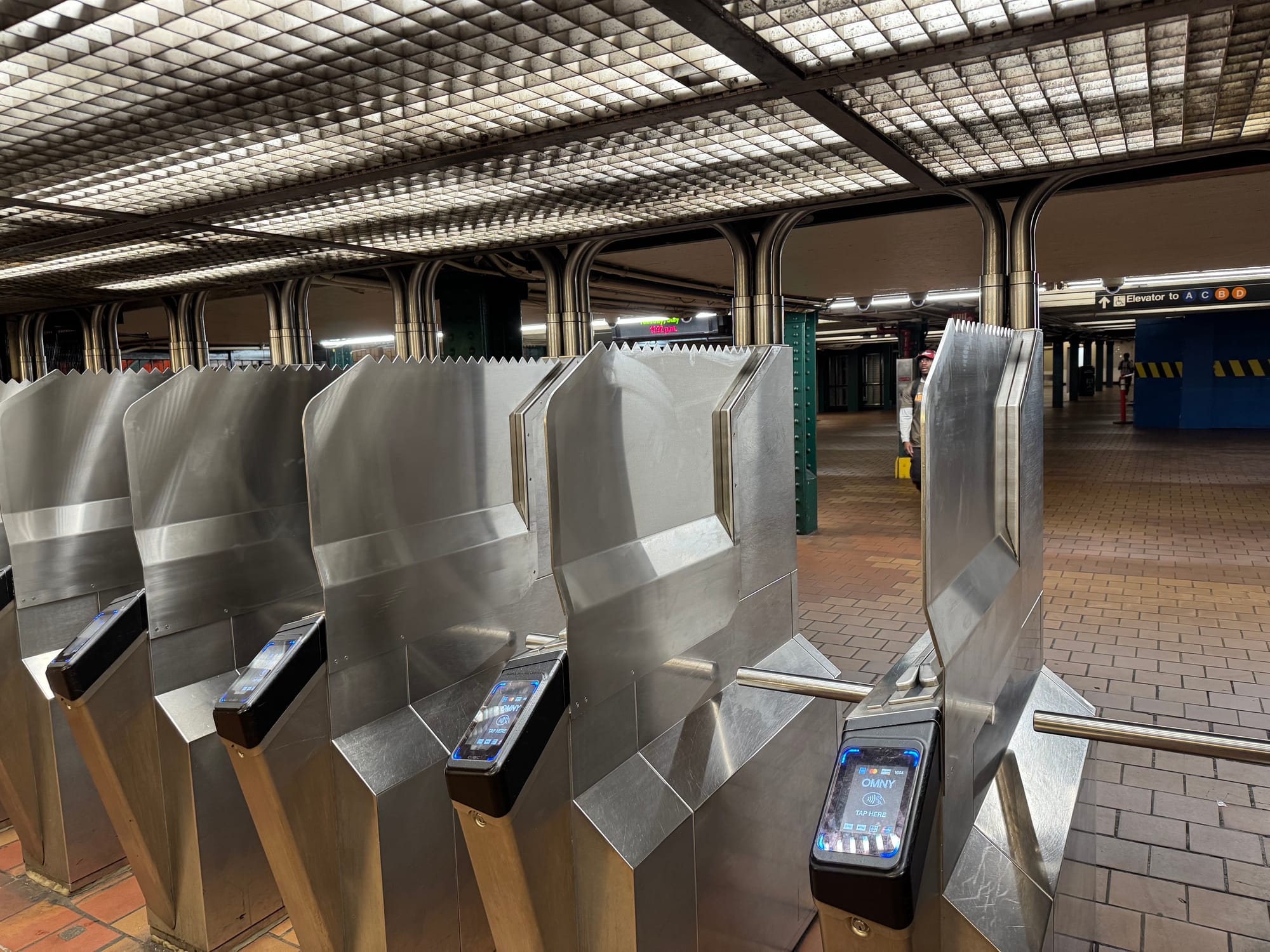Our Sunday Read: The Great Tech Vibe Shift
Tech companies used to portray themselves as do-gooders. But as Palantir's new billboard suggests, their commitment to domination was there all along.
BART fixates on fare evasion while the real issues — pricey commutes, train delays, broken elevators, and no real help in the face of fellow riders’ mental health crises — ride free.

If you’ve noticed an increase in officers checking for proof of payment on Bay Area Rapid Transit (BART) trains, it's not in your head. While taking the Red Line home from a night at the bar with friends this past Valentine’s Day, I experienced my first on-board fare check in recent memory. BART fare inspection officers — unarmed, unsworn BART Police personnel — walked down the car scanning people’s Clipper cards and doling out tickets. Watching dates and late-night commutes, I wondered how we got here and how fellow riders felt about BART’s new wave of anti-fare evasion.
What do working-class and transit-reliant people feel about these efforts? Riding on the Red line and Blue line, I found that Bay Area residents still face pricey commutes, train delays, broken elevators, and no real help in the face of fellow riders’ mental health crises.
Breanna Mezzie, a life-long Bay Area resident and member of the trade union Laborers Local 261, commutes regularly from San Francisco to Hayward. As she waits patiently on the crowded Embarcadero station platform at rush hour, I ask her how she feels about BART’s new anti-fare evasion measures. She shrugs.
To her, it feels like the “same old, same old” policies and priorities from BART. While the agency treats recent renovations as a revolution in service quality for riders, Mezzie just sees an effort to “make [the system] look good.”
While BART’s poverty policing is nothing new, its outright war on fare evaders began in 2017, when they implemented a “proof of payment” policy, with misdemeanor fines set at $75 for adults and $55 for minors found riding without the correct ticket. Enforcement started in early 2018. In justifying the unprecedented policy, agency officials claimed that fare evaders “erode the trust of honest, fare paying customers.”
Anti-fare evasion measures only intensified in 2020, when the economic crises of COVID-19 and mass shifts to remote work contributed to tanking ridership and revenue. Facing what it called a “financial cliff,” BART cut services back, threatening imminent system closure if money didn’t start flowing in.
In the past five years, BART has received federal assistance totaling $1.6 billion, and a $352 million state bailout from the California Metropolitan Transportation Commission (MTA), with critical strings attached: evidence of increases in fare revenue. These band-aids will run dry within the next year.

Even with these new hefty investments, state budget cuts and strict stipulations keep compounding, and BART continues to raise costs for riders, with a 5.5% fare raise this year alone.
While the cost of living inflates year by year, so does the cost to commute. On January 1st, 2026, BART fares will go up 6.2%. It'll be the third year in a row BART has raised prices.
When asked how she felt about new anti-fare evasion measures, Mezzie said that at the end of the day, “some people just don’t have it, don’t have the money.” To her, high fare evasion statistics just show that “everyday people are trying to survive and get around.”
It is as if riders are paying the fare to provide money for more anti-fare evasion enforcement, like the “next generation” fare gates that were installed in December 2023 at West Oakland station.
Unlike the old waist-high orange plastic barriers that were easy to push open or hop over, these seven-foot tall clear gates are made up of polycarbonate doors and reinforced with stainless steel. While the old gates fit into the 1970’s, brutalist station aesthetic, the new gates evoke the disjointed feeling of a futuristic airport gate or checkpoint. Gone is the old “clunk” sound. The new gates silently swing, with motion sensors installed to track passenger presence in the stall — in theory making it easier for people with mobility aids to move through the stalls.

BART’s current $90 million “station hardening” plan — which includes the installation of new fare evasion gates across the entire BART system by the end of 2025 — is part of a long-term trend of criminalizing fare evasion, specifically homelessness in public-private spaces.
“It’s easy to channel fears and frustrations about delays, or some homeless guy making a mess on a train," said Dylan AuBuchon, on his daily commute from Oakland to his restaurant job in San Francisco. “Keeping people out and policing behavior will not stop a bigger problem.”
At the exit of Richmond station, I talk to Amy Zarate, a social worker returning home in the evening from her daily commute to San Francisco. Her on-board experiences haven’t improved in recent months despite the new gates. She points out that even with the new staggering fare gates, she says that she's still had “people force their way through [the gate] behind me.”
I met Hans Joachim Neis on his daily commute to the University of California, San Francisco, from whom he receives a discounted fare. Neis fits the profile of who BART was built for: a salaried professional. But even as someone who can afford to pay the fare and sees the benefit of BART in his daily life, Neis is also bewildered by the new status quo on BART.
There are many reasons why people jump the fare gate, he said.“If I’m in a hurry, I would prefer to go through quickly. It’s not because of money, it’s for other reasons.”
Looking back at the new gates, he added that the new layout “feels less social, with an air of a prison. It’s a little bit coercive, there’s less freedom. It’s a tall order.”
BART has promised that these shiny new hardened stations will provide passengers with “a more cohesive and user-friendly transit experience across the region.” But over the course of two weeks reporting this story, I witnessed significant delays due to the new fare gates, with whole lines of riders facing the same “See Agent” message on a limited number of functioning gates. I observed these hold-ups during various hours of service and stations, including at MacArthur and Embarcadero.
BART claims that fare evaders are largely responsible for unsafe and inaccessible transportation, and that fare enforcement encourages more ridership and improves feelings of safety.
But safety for who? Black passengers make up 43.5% of fare evasion stops, and 59.4% of fare stops that turned into arrests. The data shows that BART officer citations disproportionately target marginalized groups, including people of color, low-income, unhoused people, and disabled people.
The Center for Policing Equity (CPE) recently released a report on the unethical and ineffective results of BART’s “punitive measures.” Despite BART’s confident claims about increased rider feelings of safety and increased fare revenue, the CPE found that these enforcement models aren’t bringing in the revenue promised, or improving riders’ sense of safety. The report also found that BART’s dependence on police — armed and unarmed — resulted in law enforcement targeting riders who are marginalized. In many cases, BART police stops start as fare checks and escalate into ID checks, physical searches and arrests.
Before the current BART fare check frenzy, Mezzie recalls witnessing BART police officers conduct a fare inspection and fine a youth. The experience stuck in her memory because it didn’t seem necessary. “He seemed like he was about to get off at the next stop.” Recalling the kid’s vulnerability in the face of the officers, she added, “Youth don’t know their rights like adults, you know?
What BART paints as a “new generation” of public transit doesn't look too different from the past few decades of tough-on-crime tactics. From the Bay Area to New York City, transit agencies have cranked up fare policing and rider surveillance under the guise of public safety and accessibility.

Zarate said that in the past few months she has witnessed several unaddressed conflicts and harassment, unrelated to tailgaters.
In 2020, BART launched the Ambassador program, a “Progressive Policing & Community Engagement" Bureau. The program deploys unarmed members of the BART Police Department to monitor stations and trains. Zarate “hasn't seen ambassadors around” to assist riders.
Glancing backwards at the elevator area at the Richmond station, Zarate said that her mom relies on a working elevator and escalator, and that they are often out of service or obstructed for extended periods of time. “Why can’t it be free?” she says. “We pay all of these taxes and stuff.”
AuBuchon would like to see “effort and outreach to get people to care [about public transit].” “I usually take the train when going to the city,” AuBuchon said. “When I do have to drive, like to a work gig, I’m stuck in gridlock. You look around and it’s one person per car, stuck.” As a commuter who also relies on his car for contract work, he makes every effort to keep transportation costs low. AuBuchon thinks that more affordable options will be helpful to everyone in the long run.
AuBuchon believes without broader social and economic support that effectively reaches people outside of BART rides, everyday problems on transit are “not going to stop.”